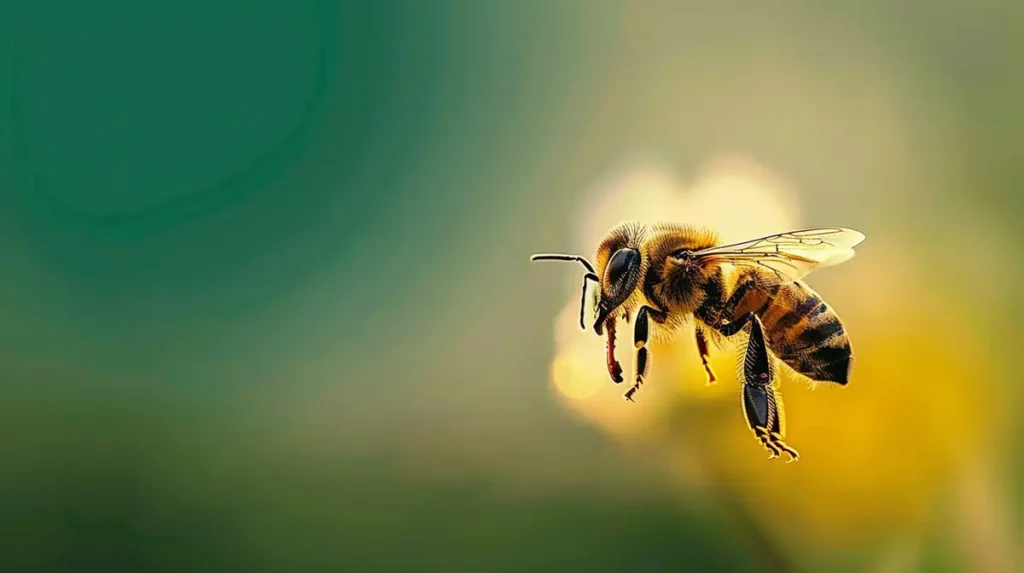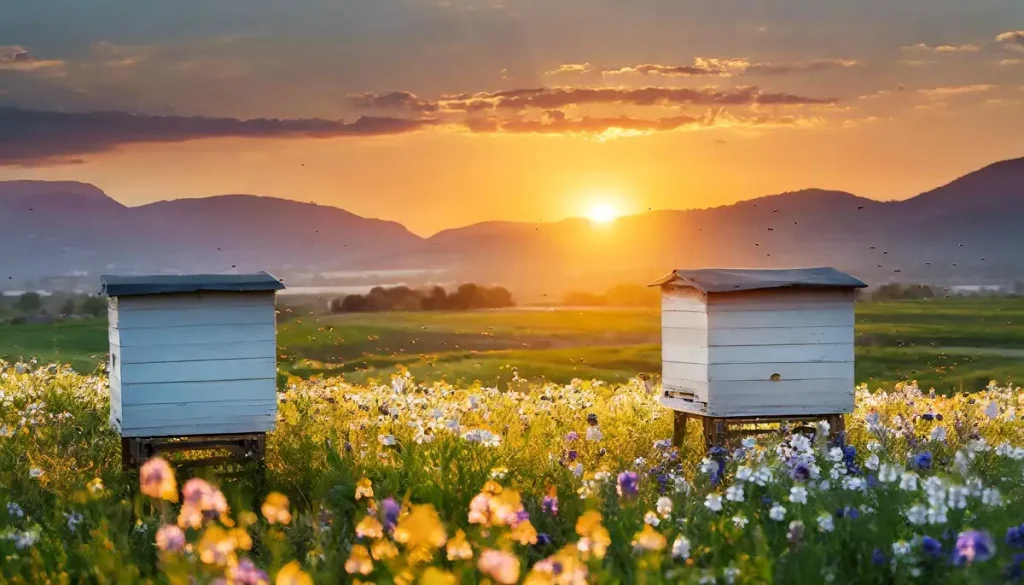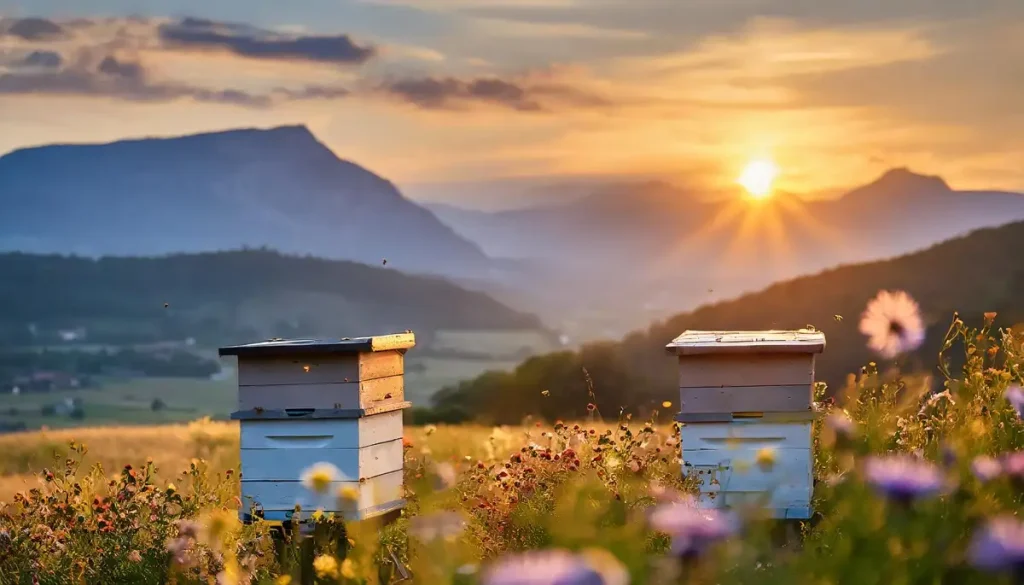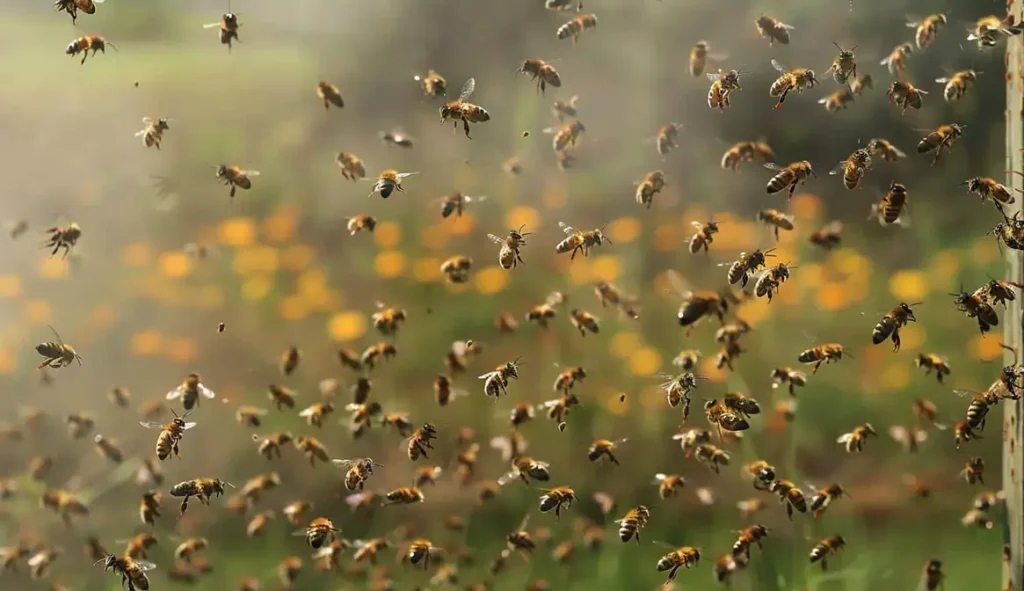Table of Contents
You are probably familiar with the life cycle of the bee. Following a simple principle that is the cornerstone of our global ecosystem, bees, lured by pollen, nectar, or a cunning flower’s pheromone-mimicking scent, will descend upon local plant life in a dance that is necessary for the continued existence of plant and bee alike. This is a fact of nature that is never very far from the beekeeper’s mind.
To collect bees in a hive, beekeepers must first encourage them to swarm in the right place. After that, the beekeeper must find a way of trapping them, sometimes using the hive they intend to keep them in, but usually using the appropriately named bait hives or trap hives.
Bees exist in highly organized societies and a swarm will always be the result of a new queen from an old colony, accompanied by half of that colony’s workforce, taking to the air under favorable conditions to find a new nesting site. A beekeeper must do what they can to provide the conditions for the new colony to form.
Many of these conditions, not least of which is the weather, are unfortunately out of the beekeeper’s hands. Swarms are encouraged to form a new colony in areas with a significant nectar flow. This is a term familiar to every beekeeper and refers to the proportion of nectar-producing plants in bloom in the area at any given time. Sometimes referred to – technically erroneously – as the honey flow, it is this which is perhaps the most essential environmental condition for attracting bee swarms. This is the whole reason bees are interested in a site – it is literally this which attracts them. Of course, there is much more to consider besides the nectar flow (and many other factors determining whether there is a nectar flow or not) that will become clear when we consider the stages involved in a swarm selecting a site and setting up a new colony.
Attracting a Swarm: First Thing’s First
Put as simply as possible, bee colonies form in an area with a high nectar flow and favorable conditions for their survival. There is, however, a definite series of steps between an old colony swarming (that is to say, a new queen taking to the air with her workers to find a home) and a new one being formed elsewhere. Generally speaking, bees will swarm at the combination of a spell of particularly fine weather (warm and gentle) and a high nectar flow. This typically means spring and summer, but not always.
Yet swarming is but the first stage on the way to the foundation of a new hive where honey can be produced. Before bees will descend anywhere, the swarm will send forth an advance guard – the so-called scout bees – to scope out potential new homes. Learning about the behavior of these scout bees is essential to being able to actively attract a swarm. Some people find themselves lucky in that the right weather, a high nectar flow, and a particularly suitable cavity all combine at the right time. Then there are some individuals, with no intention of raising bees, that can find themselves particularly unlucky in such a situation! For the most part though, attracting bees takes work, and learning about scouts is the first step.
The common impression that bees (with maybe some rivalry from the ants) are the most hardworking of insects certainly checks out in the case of scout bees. Scout bees will be the first sign a beekeeper will meet of a swarm taking interest in his or her hive. Scout bees not only spend 30 minutes or more surveying a potential site, but they often work with an initial long-list of around ten different locations, narrowing that down to two or three before settling on a final location. To say that they take their time and are thorough is rather an understatement.

Learning their behavior is essential. Scouts will first appear as one or two bees hovering inquisitively around a potential nesting location. These bees will often appear to be carefully scanning the opening of a potential hive. What happens next follows a fairly consistent pattern. If a site appears favorable to the first few scouts, more will soon appear to conduct the same thorough investigation. If the number of scouts appears to be increasing, that is a good sign. Prior to the descent of the whole swarm, the number of scouts will noticeably surge.
During this scouting period, where the emissaries of a potential swarm are busy evaluating the site, it is prudent, if not essential, to minimize physical disturbance. Quite simply, before the establishment of a colony proper – and even when there are many bees scouting around the location, they can still be very easily put off. As mentioned above, swarms evaluate many sites and it doesn’t take much for them to abandon a candidate. Accordingly, hands-off is the beekeeper’s best strategy during this stage.
To catch a swarm then, creating a hive that will impress the scouts is very much the name of the game. There are specialized trap or bait hives, but a bee colony can also very often be trapped in precisely the hive in which the beekeeper plans to house them long term. I will discuss bait hives below but, for now, it might be worth considering what type of hive – trap or otherwise – bees actually like.
The inescapable truth of the matter is that there is much that we don’t know about swarming behavior and one doesn’t have to have been particularly long in the game to have noticed the vast and varied range of cavities that a swarm will colonize. From birdboxes to hollow trees, bees consider a great many places a potential home.
A professor of biology at Cornell University, Dr. Thomas D. Seeley, published a bestselling study of the endlessly complex matter of bee society. In Honeybee Democracy (click here to open a new tab and see this book on Amazon), Seeley, going on a rigorous analysis of honeybee behavior, managed to come up with some figures for cavity volume, opening width, and height above the ground. Budding beekeepers might wish to follow these, but it must be remembered that they are the roughest of guidelines and you could well find a swarm neglecting your carefully constructed bait hive for an owl box in next door’s yard.
- Carter, Anthony (Author)
- English (Publication Language)
- 194 Pages - 02/28/2024 (Publication Date) - Independently published (Publisher)
Seeley concludes that, generally speaking, swarms prefer nesting cavities of around 40 liters volume and with an opening around two inches wide. He also concluded that height plays a role, with bees preferring to form a colony roughly 21 feet off the ground. These being only guidelines, the last point especially might be worth disregarding; if your hive is 21 feet high, the practical difficulties are obvious. It’s certainly not a bad idea to act on Seeley’s advice, but it is important to keep in mind how little we know about these remarkable creatures, their habits, and the countless mysterious factors that could go into their collective decision making processes.
Beekeepers cannot control the weather or the timing of the nectar flow, and they do not fully understand just how a swarm selects its hive. Yet having come to terms with what they cannot control, beekeepers the world over nevertheless achieve success thanks in no small part to a careful arrangement of the things they can control. From trap hives to pheromone baits and a little strategic gardening, there’s wealth of techniques when it comes to attracting, catching, and keeping a swarm of bees.
Traps and Bait to Lure the Bees
Should you be lucky to play host to a profusion of nectar producing blooms and an extended period of good weather, the chances of trapping bees look good. But what is it that beekeepers can actively do at this point to attract the scouts and, ultimately, trap the swarm?
With little to do once the scouts arrive besides taking care not to disturb them and hoping that your hive makes the cut, much of the beekeeper’s energy will go on the preparation of the hive itself. As mentioned above, bees can be very successfully trapped in the hive which is intended to be their long-term home and from which the beekeeper intends to collect honey. This is not always the case though and sometimes trap hives can be used. In both cases though bait is nearly always used.
Whatever hive you intend to use (more on this below), bait is pretty much essential. The slightly daunting truth of the matter is that there are many types of bait which can be effective. Bait lures bees with an attractive scent or a material – or structure – that they require to live. Accordingly, baits can be as highly developed as an artificial pheromone solution or as primitive as an old brood comb from an older hive. Both of these baits, by way of example, can be highly effective. Remember, it will always be a combination of factors that encourage bees to settle; whatever bait you use will interact with other meteorological and environmental factors in order to, hopefully, entice a swarm to colonize your hive.
What are Bait Hives
At the end of the day, a bait hive is, in truth, just a hive. Beekeepers often set them up with both a used comb and empty frames with space for the construction of a new comb. The simple logic behind this is that, apart from releasing an attractive scent, the old comb will give the queen a place to immediately start laying eggs (provided she has already mated). This pre-installed structure turns out to be a major attractive factor. The empty frames, on the other hand, are there to encourage the building of comb, which the workers are eager to do, and which is an essential process for the establishment of a hive.
At the stage of preparing the hive, there is much more beekeepers can do to improve their chances. As mentioned above, keeping the opening to no more than a few inches gives the hive some structural protection against adverse weather (which bees appreciate). It also keeps out mice and other rodents, which can actually be a major threat to the structural integrity of the hive. The incursion of rodents can also be prevented by placing the hives high up, which, as we have already mentioned, also makes them more attractive to bees. That said, Seeley’s optimal 21 feet is still hardly worth the practical difficulties – a couple or so meters up is fine.
Of the many types of hives that can successfully capture a swarm, a special mention is perhaps due to the Langstroth hive, which satisfies Seeley’s 40 liters’ volume and small opening recommendation. You can also get around the height issue by means of a lightweight bait hive designed to be placed higher up. These are removable and manageable but cannot be used long term for your hive. Accordingly, you will have to transfer the colony to a new hive once established, which brings with it a host of tricky practicalities (as well as the slight risk of adverse factors affecting the colony).

Diseases are, at this stage, actually a major concern. When trapping wild bee swarms, you simply cannot know if they are carrying diseases, which is something that the beekeeper needs to keep in mind. Once settled in your hive, new colonies will have to be isolated until the beekeeper can be satisfied, through examination of the hives, that the colony is disease-free. Luckily, all isolation means in this context is refraining from exchanging frames with other hives and washing gloves and hive tools after use.
There is also the matter of the pesky wax moth, which can prove disastrous for the beekeeper as it is only too happy to lay its eggs in the empty comb left out to entice bees. Once the larvae develop, they destroy the comb. Preventing this fate is a matter of regularly checking the combs (of course), freezing any old combs before use in a new hive (this will kill any moth eggs), and sticking to the swarming season (different from the moth mating season) when setting out bait hives.
Of course, the nectar will flow when it flows and the good weather will come when it comes, so the beekeeper can never be totally precise in these matters. If the conditions look favorable, it is time to take necessary precautions and set the bait hives out.
The Bait for Luring Bees
Regardless of what bait you use, less is more. Using too much of any bait will simply have the opposite effect to that intended. Bees will steer well clear of hives dripping with gloopy bait. A good practical, if rough, metric is to examine the smell; it should not be even slightly offensive to the human nose. Humans’ sense of smell is rather limited; if it smells strong to you, it will only repel bees.
So, what is the best bait to use? Well, if there was one clear winner, there wouldn’t be so many baits out there. What bait works best in combination with your particular environment and climate is unfortunately a matter of trial and error. That said, the natural baits like the old brood comb are so widely recommended because they usually work. Just make sure it is definitely a brood comb. Any honey in an empty hive will only attract ants.
Beyond this, baits can range from scented pine sol to melted slum gum. The beekeeper can also make their own, which has the added benefit of allowing them to tweak to formula to account for non-bait factors and create a bait fully in harmony with them. A popular recipe is to place a small amount of alcohol (usually rubbing alcohol) in a container and to crush up a dead queen bee into the mixture. What this creates is a powerful bait infused with the queen’s pheromone scent, which is a major attraction for swarms. The small amount that is typically created is testament to the less is more rule. There will be little more than half a cup, for example, of this bait to spread around the hive.
Many baits utilize pheromones. In fact, in many commercially available baits this is the key ingredient. Sold in little phials, they are generally good for one season only. Such bait might be insufficient by itself, however. So numerous, variable, and partially out of all control are the factors that decide whether or not a swarm will be caught that many beekeepers choose to optimize conditions with the inclusion of a nearby sugar water feeding station. Most of us are familiar with sugar water’s almost miraculous ability to restore the energy of an exhausted bee. Providing that energy for the first few colonists can really help things along.
Generally speaking, the things that the beekeeper keeps in mind at the baiting stage is the efficacy of pheromones and the twin key principles: first that bees prefer previously occupied combs and hives and second that bait should be used very sparingly. Beyond this, a complex interaction of factors prevents any hard and fast rules.

What Constitutes Success in Attracting Bees
So the beekeeper has constructed a hive of optimal shape and dimensions, he or she has armed it with the appropriate bait and internal structures, placed it in an optimal position to catch a swarm, and provided a nearby sugar water facility to boost the energy of scouts. What does he or she do when the unmistakable signs of a colony-in-residence present themselves?
As mentioned above, the following course of action will be very much determined by whether or not the bees have to be transferred to another hive. Transferring a colony can be, as we have mentioned, a tricky business. But before even that, the beekeeper will check the maturity of their colony.
When the activity seems frantic, and pollen-encumbered bees are seen to enter and exit almost like clockwork, then you have been successful. However, before doing anything else, the beekeeper will check if the queen is ‘marked,’ thereby determining if she is a virgin or if eggs are already being laid. By marked we mean that she has been, during her time at the old colony, marked by a beekeeper with a colored spot indicating her age. If the queen is marked, she is likely to be at least one year old and therefore producing eggs. If the queen is unmarked then she was too young at the old colony to have been noticed, and marked, or the beekeeper might simply not have gotten round to it yet! In either case she is likely younger and therefore a virgin, which means the beekeeper would be prudent to wait some time before doing anything to the hive. This will allow the queen to go on her vital mating flights undisturbed.
If the hive needs to be moved at this point (this could be for many reasons, not just transferring the population to another hive) then it is important to do this gradually. Even once the queen is laying, physical disturbance is generally bad (this is another beekeeping rule of thumb). To move the hive then, beekeepers will do so in increments of three feet each day in order to allow the bees time to settle again after each relocation.
Post-swarm colonization is also a good time to encourage the construction of your hive. The bees you have lured are unlikely to be satisfied with a single old brood comb and are likely to get to work producing beeswax and building on your empty frames. This can be encouraged by feeding the bees regularly with a thin (proportions 1:1) syrup. Able to instantly convert this to wax, this will lead to a fuller internal construction faster. The more fully constructed your hive is, the more stable and resident its population will be, making this a widely recommended technique.
Once a beekeeper has lured a swarm, the name of the game becomes establishing the colony, preserving it and protecting it from diseases and pests and, ultimately, to harvest the sweet, rich rewards in the form of a season’s honey harvest. Everyone eager to begin beekeeping should remember that bees must be wooed before rewarding you with their bounty.
How to Attract Bees – The Conclusion
In conclusion, attracting bees to a beekeeper’s hive requires careful consideration and attention to detail. By providing a suitable location, a clean and well-maintained hive, and a reliable source of food, beekeepers can attract and maintain healthy and productive bee colonies. The use of attractants, such as pheromones and essential oils, can also be helpful in drawing in bees to a new hive. Additionally, it is important to remember that attracting bees is just the first step in successful beekeeping. Beekeepers must also be knowledgeable about bee behavior, hive management, and honey production to ensure the long-term health and productivity of their colonies. By adopting best practices and continually educating themselves, beekeepers can enjoy the many benefits of beekeeping while contributing to the important work of supporting the bee population and promoting a healthy ecosystem.
Looking to up your beekeeping game? Check out our latest product recommendations so you can take things to the next level!
Introducing The Top 12 Best Beekeeping Veils For 2024
Introducing The Top 20 Best Beekeeping Gloves For 2024
Introducing The Absolute Best Beekeeping Suits For 2024
The 15 Top Beekeeping Books for 2024
The Top 11 Honey Extractors for 2024
The Top 12 Mason Bee Houses for 2024
Beekeeping Disclaimer:
Beekeeping, like any agricultural activity, involves inherent risks. It is important to understand these risks and take appropriate measures to mitigate them.
Potential risks associated with beekeeping include:
- Bee stings: Honey bees are generally not aggressive but can become defensive if they feel threatened or their hive is disturbed. Bee stings can cause allergic reactions or even anaphylaxis in some individuals, which can be life-threatening. It is important to wear protective clothing and follow best practices when handling bees to minimize the risk of stings.
- Diseases and pests: Bees can be vulnerable to various diseases and pests, including mites, viruses, and bacterial infections. These can have significant impacts on bee colonies, leading to reduced honey production or even colony collapse. It is important to monitor hives regularly and take appropriate measures to prevent and treat diseases and pests.
- Weather conditions: Extreme weather conditions, such as drought or cold temperatures, can affect the health and productivity of bee colonies. It is important to ensure that hives are appropriately sheltered and provided with adequate food and water.
- Environmental hazards: Bees can be affected by environmental hazards such as pesticide exposure, pollution, and habitat loss. It is important to be aware of these hazards and take appropriate measures to protect bee colonies and promote healthy environments for bees.
- Legal requirements: Beekeeping may be subject to local, state, or national regulations, such as registration or inspection requirements. It is important to be aware of these requirements and comply with them.
While beekeeping can be a rewarding and enjoyable activity, it is important to be aware of the potential risks and take appropriate measures to mitigate them. By following best practices and staying informed about the latest developments in beekeeping, beekeepers can help ensure the health and productivity of their hives and contribute to the well-being of bee populations worldwide.
Last update on 2024-04-17 / Affiliate links / Images from Amazon Product Advertising API


